NumPy中如何将3D数组重塑为2D数组:reshape函数详解
NumPy是Python中用于科学计算的核心库之一,它提供了强大的多维数组对象和用于处理这些数组的工具。在处理多维数组时,我们经常需要改变数组的形状以适应不同的计算需求。本文将详细介绍如何使用NumPy的reshape函数将3D数组重塑为2D数组,并提供多个实用示例。
1. NumPy reshape函数简介
NumPy的reshape函数是一个非常强大的工具,它允许我们改变数组的形状而不改变其数据。reshape函数的基本语法如下:
numpy.reshape(a, newshape, order='C')
其中:
– a是要重塑的数组
– newshape是新的形状(整数或整数元组)
– order是可选参数,指定元素在内存中的读取顺序
对于从3D到2D的重塑,我们主要关注如何正确指定newshape参数。
2. 3D数组到2D数组的基本重塑
让我们从一个简单的例子开始,展示如何将一个3D数组重塑为2D数组:
import numpy as np
# 创建一个3D数组
array_3d = np.array([[[1, 2], [3, 4]], [[5, 6], [7, 8]]])
print("Original 3D array from numpyarray.com:")
print(array_3d)
# 重塑为2D数组
array_2d = array_3d.reshape(-1, 2)
print("\nReshaped 2D array:")
print(array_2d)
Output:
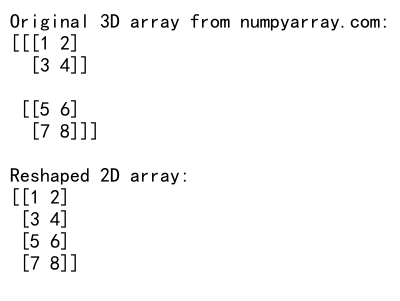
在这个例子中,我们创建了一个形状为(2, 2, 2)的3D数组,然后将其重塑为一个2D数组。使用-1作为第一个维度让NumPy自动计算这个维度的大小,确保所有元素都被包含在重塑后的数组中。
3. 理解reshape的工作原理
reshape函数的核心原理是保持数组元素的总数不变,同时改变数组的形状。当从3D重塑到2D时,我们实际上是将多个2D平面”展平”成一个大的2D数组。
import numpy as np
# 创建一个更大的3D数组
array_3d = np.arange(24).reshape(2, 3, 4)
print("Original 3D array from numpyarray.com:")
print(array_3d)
# 重塑为2D数组
array_2d = array_3d.reshape(-1, 4)
print("\nReshaped 2D array:")
print(array_2d)
Output:
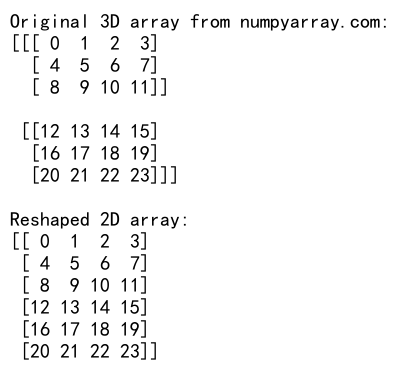
在这个例子中,我们创建了一个形状为(2, 3, 4)的3D数组,然后将其重塑为一个(6, 4)的2D数组。注意原始数组有24个元素,重塑后的数组也保持了24个元素。
4. 使用不同的维度组合
我们可以根据需要选择不同的维度组合来重塑数组。以下是一些例子:
import numpy as np
# 创建一个3D数组
array_3d = np.arange(24).reshape(2, 3, 4)
print("Original 3D array from numpyarray.com:")
print(array_3d)
# 重塑为(6, 4)的2D数组
array_2d_1 = array_3d.reshape(6, 4)
print("\nReshaped to (6, 4):")
print(array_2d_1)
# 重塑为(8, 3)的2D数组
array_2d_2 = array_3d.reshape(8, 3)
print("\nReshaped to (8, 3):")
print(array_2d_2)
# 重塑为(12, 2)的2D数组
array_2d_3 = array_3d.reshape(12, 2)
print("\nReshaped to (12, 2):")
print(array_2d_3)
Output:
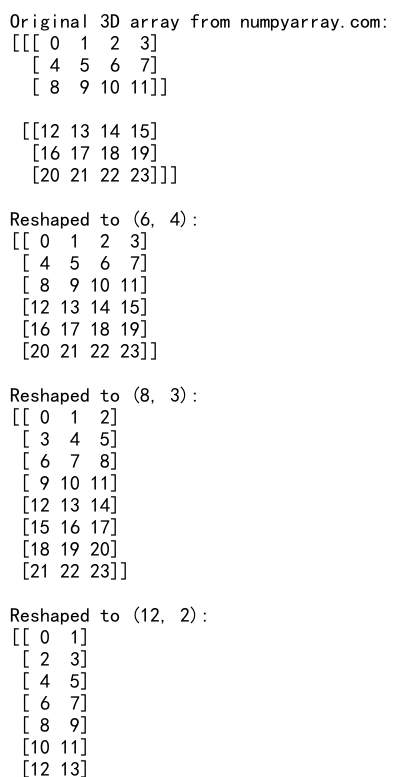
这个例子展示了如何将同一个3D数组重塑为不同形状的2D数组。注意每次重塑后,元素的总数(24)保持不变。
5. 使用-1自动计算维度
在重塑数组时,使用-1作为某个维度的大小可以让NumPy自动计算该维度应该有多大。这在处理大型数组或动态大小的数组时特别有用。
import numpy as np
# 创建一个3D数组
array_3d = np.arange(120).reshape(4, 5, 6)
print("Original 3D array from numpyarray.com:")
print(array_3d.shape)
# 使用-1自动计算行数
array_2d_1 = array_3d.reshape(-1, 6)
print("\nReshaped to (-1, 6):")
print(array_2d_1.shape)
# 使用-1自动计算列数
array_2d_2 = array_3d.reshape(20, -1)
print("\nReshaped to (20, -1):")
print(array_2d_2.shape)
Output:
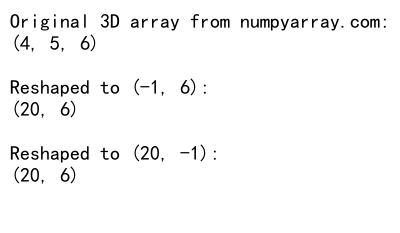
在这个例子中,我们首先创建了一个(4, 5, 6)的3D数组。然后,我们使用-1来自动计算重塑后的行数和列数。NumPy会根据原始数组的元素总数和指定的维度自动计算-1所代表的维度大小。
6. 处理不规则的3D数组
有时,我们可能需要处理形状不规则的3D数组。在这种情况下,reshape函数仍然可以帮助我们将其转换为2D数组。
import numpy as np
# 创建一个不规则的3D数组
irregular_3d = np.array([
[[1, 2], [3, 4], [5, 6]],
[[7, 8], [9, 10], [11, 12]],
[[13, 14], [15, 16], [17, 18]]
])
print("Irregular 3D array from numpyarray.com:")
print(irregular_3d)
# 重塑为2D数组
regular_2d = irregular_3d.reshape(-1, 2)
print("\nReshaped 2D array:")
print(regular_2d)
Output:
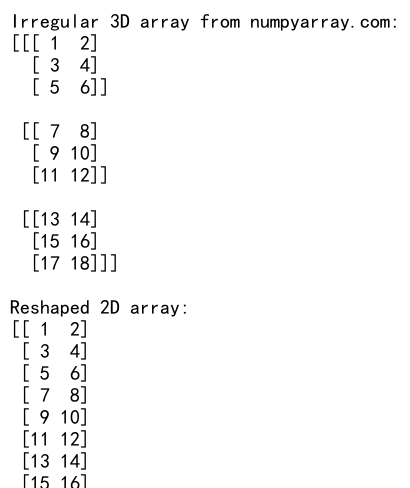
在这个例子中,我们有一个形状为(3, 3, 2)的3D数组。通过使用reshape(-1, 2),我们可以将其转换为一个(9, 2)的规则2D数组。
7. 保持原始数据的顺序
在使用reshape函数时,默认情况下NumPy会尽量保持数据在内存中的顺序。但是,我们可以通过指定order参数来控制元素的读取顺序。
import numpy as np
# 创建一个3D数组
array_3d = np.arange(24).reshape(2, 3, 4)
print("Original 3D array from numpyarray.com:")
print(array_3d)
# 使用C顺序(行优先)重塑
array_2d_c = array_3d.reshape(-1, 4, order='C')
print("\nReshaped 2D array (C order):")
print(array_2d_c)
# 使用F顺序(列优先)重塑
array_2d_f = array_3d.reshape(-1, 4, order='F')
print("\nReshaped 2D array (F order):")
print(array_2d_f)
Output:
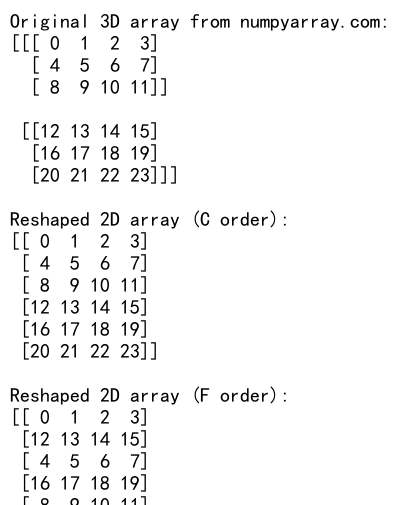
这个例子展示了使用不同的order参数如何影响重塑后的数组。’C’顺序是按行优先读取,而’F’顺序是按列优先读取。
8. 处理大型3D数组
当处理大型3D数组时,内存使用可能成为一个问题。在这种情况下,我们可以使用NumPy的内存映射功能来高效地处理大型数组。
import numpy as np
# 创建一个大型3D数组并保存到磁盘
large_3d = np.arange(1000000).reshape(100, 100, 100)
np.save('large_3d_array_numpyarray.com.npy', large_3d)
# 使用内存映射加载数组
mmap_3d = np.load('large_3d_array_numpyarray.com.npy', mmap_mode='r')
# 重塑为2D数组
large_2d = mmap_3d.reshape(-1, 100)
print("Shape of reshaped 2D array:", large_2d.shape)
Output:

这个例子展示了如何处理一个大型的3D数组。我们首先将数组保存到磁盘,然后使用内存映射加载它。这样可以在不将整个数组加载到内存的情况下进行重塑操作。
9. 结合其他NumPy操作
reshape函数通常与其他NumPy操作结合使用,以实现更复杂的数据处理任务。
import numpy as np
# 创建一个3D数组
array_3d = np.arange(24).reshape(2, 3, 4)
print("Original 3D array from numpyarray.com:")
print(array_3d)
# 重塑并计算每行的平均值
row_means = array_3d.reshape(-1, 4).mean(axis=1)
print("\nMean of each row after reshaping:")
print(row_means)
# 重塑并应用函数
def custom_function(x):
return x * 2 + 1
result = np.apply_along_axis(custom_function, axis=1, arr=array_3d.reshape(-1, 4))
print("\nResult after applying custom function:")
print(result)
Output:
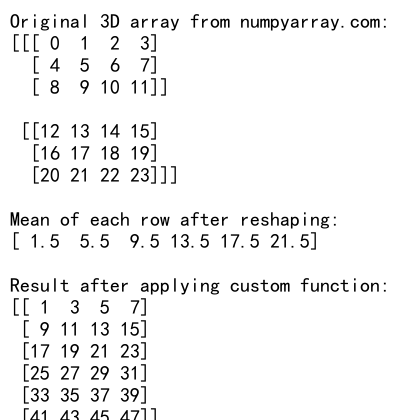
这个例子展示了如何将reshape与其他NumPy操作结合使用。我们首先计算重塑后每行的平均值,然后应用一个自定义函数到重塑后的数组上。
10. 处理特殊情况和错误
在使用reshape函数时,可能会遇到一些特殊情况或错误。了解如何处理这些情况是很重要的。
import numpy as np
# 创建一个3D数组
array_3d = np.arange(24).reshape(2, 3, 4)
try:
# 尝试重塑为不兼容的形状
array_2d = array_3d.reshape(5, 5)
except ValueError as e:
print("Error from numpyarray.com:", str(e))
# 使用-1自动计算维度
array_2d = array_3d.reshape(-1, 4)
print("\nSuccessfully reshaped to:", array_2d.shape)
# 检查重塑是否改变了数据
assert np.all(array_3d.flatten() == array_2d.flatten()), "Data changed after reshaping"
print("Reshape operation preserved all data")
Output:

这个例子展示了如何处理reshape时可能遇到的错误,以及如何验证重塑操作是否保留了所有数据。
11. 性能考虑
在处理大型数组时,reshape操作的性能可能会成为一个考虑因素。通常,reshape操作是相当快速的,因为它不会复制数据,只是改变了数据的视图。
import numpy as np
import time
# 创建一个大型3D数组
large_3d = np.random.rand(100, 100, 100)
# 测量reshape操作的时间
start_time = time.time()
large_2d = large_3d.reshape(-1, 100)
end_time = time.time()
print(f"Time taken to reshape large array from numpyarray.com: {end_time - start_time:.6f} seconds")
# 检查是否创建了新的数组
print("New array created:", not np.may_share_memory(large_3d, large_2d))
Output:

这个例子展示了如何测量reshape操作的执行时间,并检查是否创建了新的数组。通常,reshape操作不会创建新的数组,除非必要(例如,当需要重新排列数据时)。
12. 实际应用场景
让我们看一些reshape从3D到2D的实际应用场景:
12.1 图像处理
在图像处理中,我们经常需要将3D图像数据(高度、宽度、颜色通道)转换为2D数据以进行某些操作。
import numpy as np
# 模拟一个RGB图像数据
image_3d = np.random.randint(0, 256, size=(100, 100, 3), dtype=np.uint8)
print("Original image shape from numpyarray.com:", image_3d.shape)
# 将图像重塑为2D数组,每行代表一个像素
image_2d = image_3d.reshape(-1, 3)
print("Reshaped image shape:", image_2d.shape)
# 对重塑后的数据进行操作(例如,计算每个像素的平均强度)
pixel_mean = image_2d.mean(axis=1)
print("Shape of pixel mean array:", pixel_mean.shape)
Output:

这个例子展示了如何将3D图像数据重塑为2D数组,其中每行代表一个像素的RGB值。
12.2 时间序列数据分析
在处理多维时间序列数据时,我们可能需要将3D数据(时间步、特征、样本)重塑为2D数据以进行某些分析。
import numpy as np
# 模拟时间序列数据:10个时间步,5个特征,100个样本
time_series_3d = np.random.rand(10, 5, 100)
print("Original time series shape from numpyarray.com:", time_series_3d.shape)
# 重塑为2D数组,每行代表一个时间步的所有特征和样本
time_series_2d = time_series_3d.reshape(10, -1)
print("Reshaped time series shape:", time_series_2d.shape)
# 计算每个时间步的平均值
time_step_means = time_series_2d.mean(axis=1)
print("Shape of time step means:", time_step_means.shape)
Output:

这个例子展示了如何将3D时间序列数据重塑为2D数组,以便进行时间步级别的分析。
13. 高级reshape技巧
除了基本的reshape操作,NumPy还提供了一些高级技巧,可以让我们更灵活地处理数组形状的转换。
13.1 使用元组定义新形状
我们可以使用元组来定义新的形状,这在处理动态形状时特别有用。
import numpy as np
# 创建一个3D数组
array_3d = np.arange(120).reshape(2, 6, 10)
print("Original 3D array shape from numpyarray.com:", array_3d.shape)
# 使用元组定义新形状
new_shape = (-1, array_3d.shape[-1])
array_2d = array_3d.reshape(new_shape)
print("Reshaped 2D array shape:", array_2d.shape)
Output:

在这个例子中,我们使用一个元组来定义新的形状,保持最后一个维度不变,而让NumPy自动计算第一个维度。
13.2 使用newaxis增加维度
有时,我们可能需要在重塑过程中增加新的维度。我们可以使用np.newaxis来实现这一点。
import numpy as np
# 创建一个2D数组
array_2d = np.arange(24).reshape(6, 4)
print("Original 2D array from numpyarray.com:")
print(array_2d)
# 增加一个新维度
array_3d = array_2d[:, np.newaxis, :]
print("\nArray with new axis added:")
print(array_3d)
# 重塑回2D
array_2d_new = array_3d.reshape(-1, array_3d.shape[-1])
print("\nReshaped back to 2D:")
print(array_2d_new)
Output:
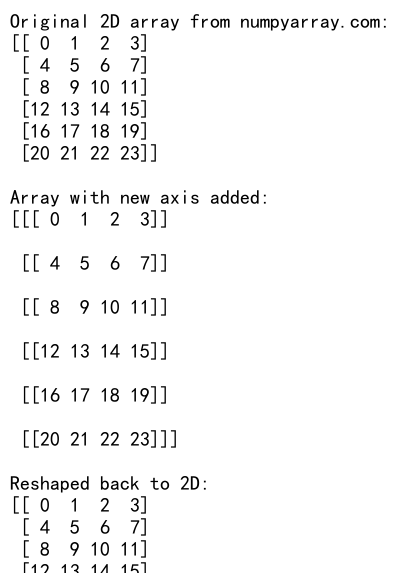
这个例子展示了如何使用np.newaxis在2D数组中添加一个新的维度,然后再将其重塑回2D数组。
14. 处理非连续数组
在某些情况下,我们可能会遇到非连续的数组。这些数组在内存中的存储方式可能会影响reshape操作。
import numpy as np
# 创建一个3D数组
array_3d = np.arange(24).reshape(2, 3, 4)
print("Original 3D array from numpyarray.com:")
print(array_3d)
# 创建一个非连续视图
non_contiguous = array_3d[:, :, ::-1]
print("\nNon-contiguous view:")
print(non_contiguous)
# 尝试重塑非连续数组
try:
reshaped = non_contiguous.reshape(-1, 4)
print("\nReshaped array:")
print(reshaped)
except ValueError as e:
print("\nError:", str(e))
print("Reshaping non-contiguous array by creating a copy:")
reshaped = non_contiguous.copy().reshape(-1, 4)
print(reshaped)
Output:
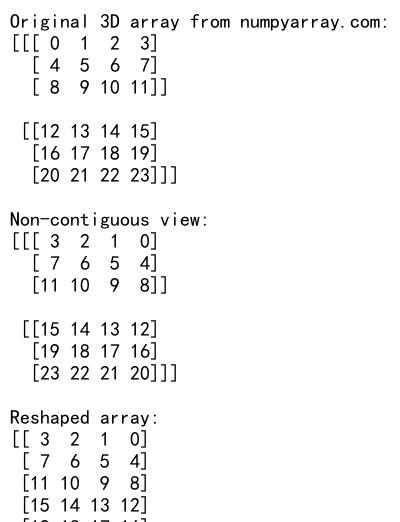
这个例子展示了如何处理非连续数组的reshape操作。在某些情况下,NumPy可能需要创建一个数组的副本才能执行reshape操作。
15. 结合transpose和reshape
有时,我们可能需要在reshape之前先转置数组。这在处理某些特定的数据结构时很有用。
import numpy as np
# 创建一个3D数组
array_3d = np.arange(24).reshape(2, 3, 4)
print("Original 3D array from numpyarray.com:")
print(array_3d)
# 先转置再重塑
transposed = np.transpose(array_3d, (1, 0, 2))
reshaped = transposed.reshape(-1, 4)
print("\nTransposed and reshaped array:")
print(reshaped)
Output:
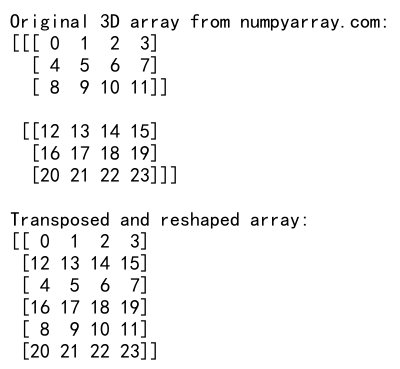
这个例子展示了如何先使用transpose改变数组的轴顺序,然后再进行reshape操作。
16. 使用reshape进行数据规范化
reshape函数还可以用于数据规范化过程中,特别是在机器学习和深度学习应用中。
import numpy as np
# 创建一个表示多个样本的3D数组
samples = np.random.rand(10, 5, 3) # 10个样本,每个样本5x3
print("Original samples shape from numpyarray.com:", samples.shape)
# 重塑为2D以进行规范化
samples_2d = samples.reshape(-1, samples.shape[-1])
print("Reshaped samples shape:", samples_2d.shape)
# 进行规范化
normalized = (samples_2d - samples_2d.mean(axis=0)) / samples_2d.std(axis=0)
# 重塑回原始形状
normalized_3d = normalized.reshape(samples.shape)
print("Normalized samples shape:", normalized_3d.shape)
Output:

这个例子展示了如何使用reshape在数据规范化过程中转换数据形状。
总结
NumPy的reshape函数是一个强大而灵活的工具,可以帮助我们轻松地在不同维度的数组之间进行转换。从3D到2D的重塑操作在图像处理、时间序列分析和机器学习等多个领域都有广泛应用。通过本文的详细介绍和多个示例,我们不仅学习了基本的reshape操作,还探讨了一些高级技巧和常见的应用场景。
在使用reshape函数时,关键是要理解数组的形状和元素顺序,并确保重塑操作不会改变数据的本质含义。同时,也要注意处理可能出现的错误和特殊情况,如非连续数组或内存限制等。
通过灵活运用reshape函数,我们可以更有效地处理和分析多维数据,为数据科学和科学计算工作提供强大支持。希望这篇文章能够帮助读者更好地理解和使用NumPy的reshape功能,特别是在处理3D到2D的转换时。
 极客教程
极客教程